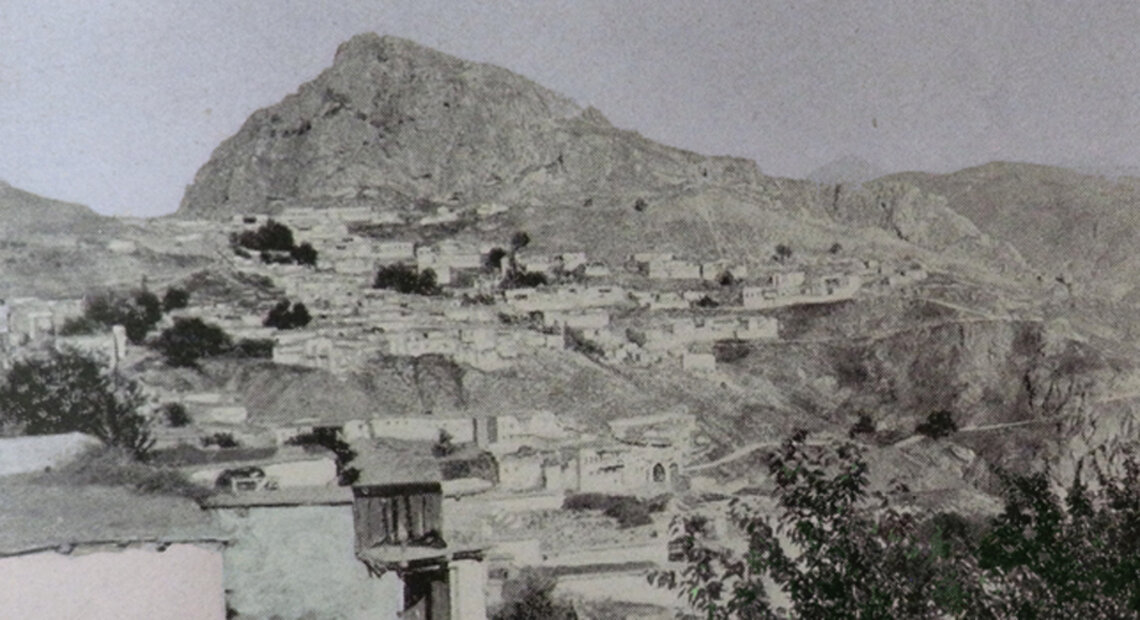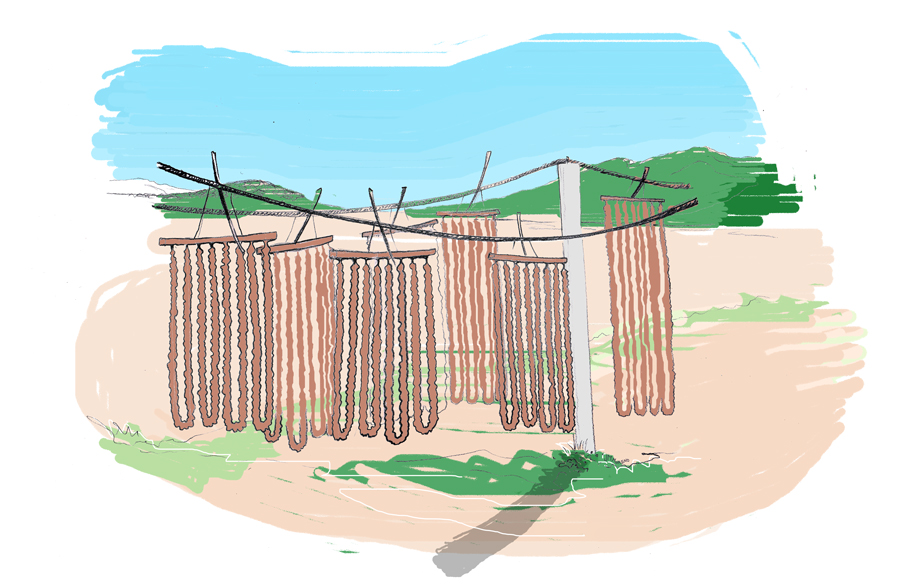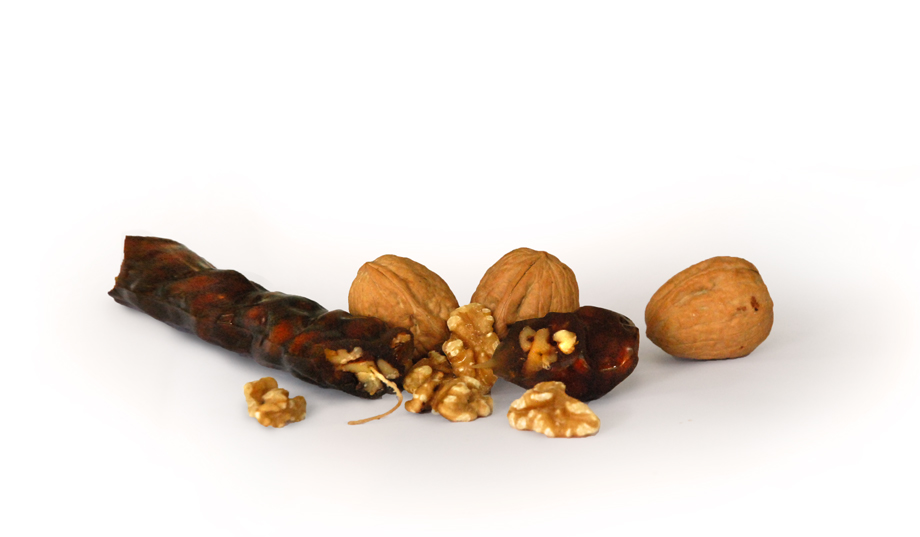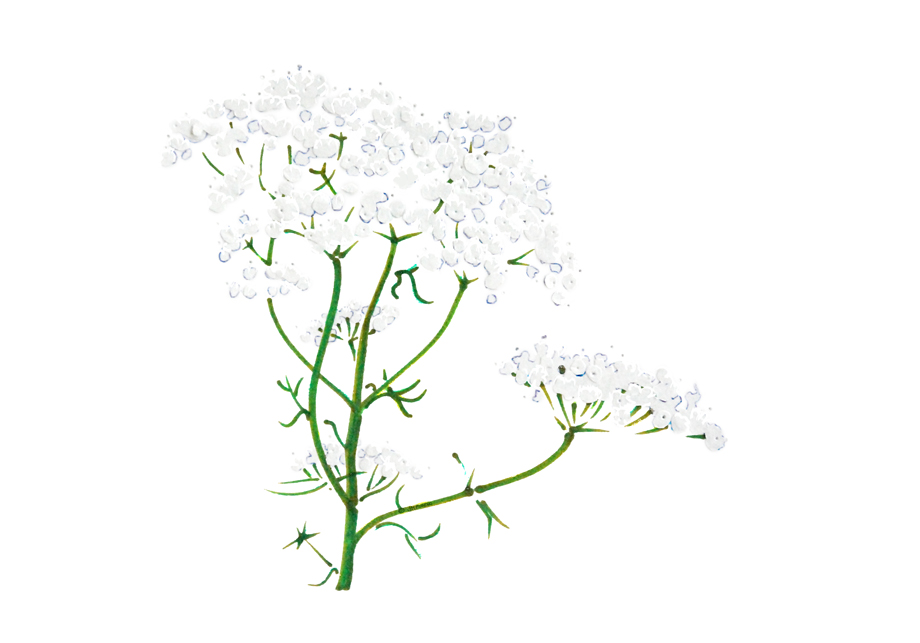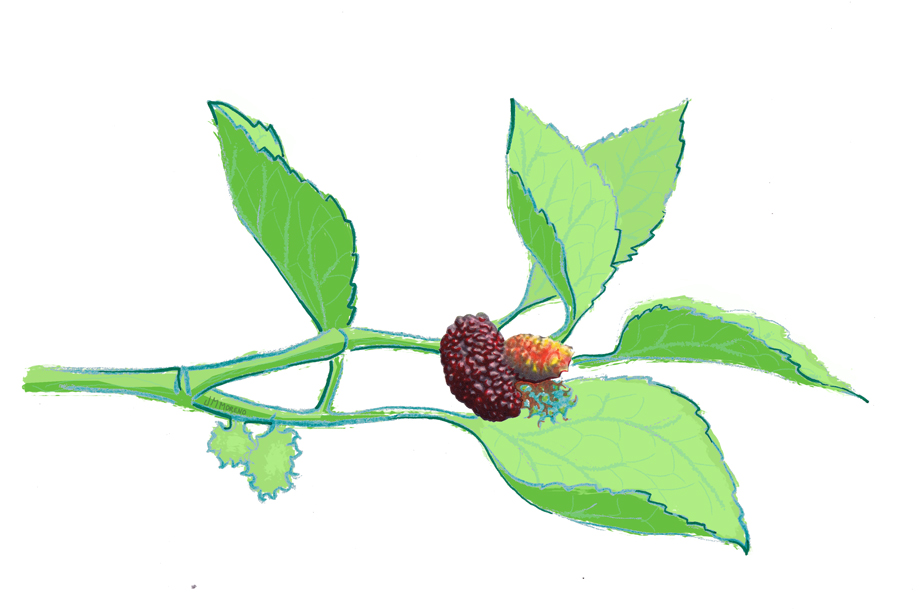Palu - Agriculture (Trees)
Grapevines - Grapes
Vineyard and vine
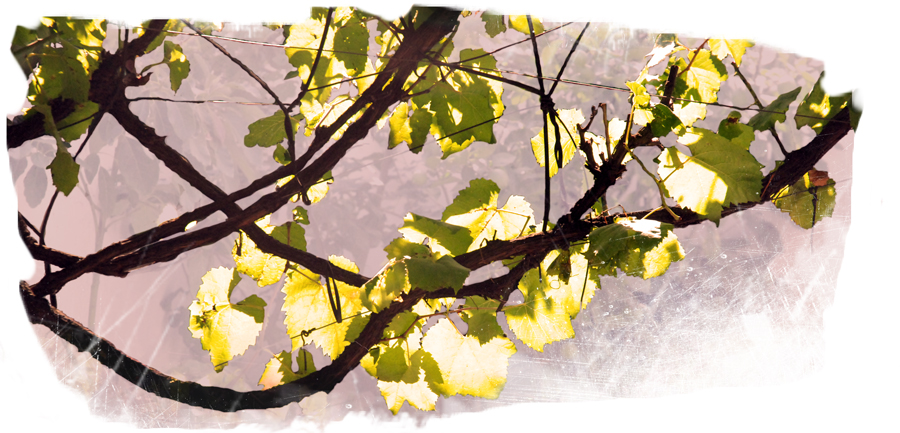
The grapevine and mulberry tree are the most important trees in the Palu rural economy. Apart from the fact that grapes are eaten in their ordinary state, the villager also makes grape syrup, sweetmeats and wine from them.
Vineyards are usually established in dry, sunny places. They are located on mountain slopes that face east and are in the sun for most of the day. For the villager the grapes from these dry arid vineyards are the more prized, as the must (the juice used for wine-making etc) made from these grapes is thicker and sweeter. The Palu vineyards are separated one from another by stone walls, called chor kar (dry stones); they are simple dry stone walls, without mortar being used. Sometimes the vineyards are simply separated by clumps of grass, given the name of gort or sinor. [1]
Planting vines: this takes place in the second half of March. In the first instance, the ground of the future vineyard is cleared of stones and every kind of grass and weeds and ploughed. Then holes are dug, one metre apart, in straight lines, such that each vine has about one square metre of free space around it. A specially chosen young vine branch, called an ur or chach, and about a metre long is planted vertically in each hole, such that three quarters of the plant is below the surface, and the hole is filled in. It can happen that the branch is more than a metre long. In this case it is bent and, without cutting it, is made into two branches. The bend itself is put into the hole and the hole filled in. Both ends of the branch remain above ground, two plants developing from it. Each line of vines planted in the vineyard is called by the people of Palu a baran, which is also the unit of measurement for the size of the vineyard. For example, a ‘20-baran vineyard’ means it has 20 lines of vines, each line containing 20 vines. In other words this is a vineyard with 400 vines in it. The baran unit is also used to measure the quantities of other kinds of tree. There is no irrigation, the rainfall being enough for the branches to take root and flourish. [2]
In May, when the vines have begun to produce green shoots, the villager begins various activities to cultivate the vineyard. One of them is called ekin panal (to open the vineyard). This takes place a year or two after the vines have been planted and are well rooted. The cultivator digs a deep trench all round the plant called an achk (eye). In this way the young plant’s roots have access to the air and to breathe in life-giving oxygen. These trenches are left as they are; rainwater fills them and the dampness spreads. The vine needs no other irrigation.
The ekin panal (opening the vineyard) operation is succeeded by pruning the vines, using a knife with a curved blade. The cultivator begins to prune the branchlets (called mol) that have developed on the vine, thus eventually only leaving the main branches – likewise called by the same name. As a result these can grow and develop better. Then the next operation is to dig the entire vineyard from one end to the other with sharp-bladed spades; the grass is uprooted, and the soil ploughed. An important part in this work of cultivation is played by the special staves called sarpina that are used to support the vines in the vineyard. The sarpina is a slightly curved rough stave with one end having a fork in it, like a v. After pruning the vines, the cultivator brings bundles of these staves to the vineyard. Each vine has one stuck in the ground next to it at an angle, with the fork uppermost. If the vine concerned has a lot of shoots, then it is possible that two staves are used. The branches of the vine are then lifted and put on to the fork of the stave. A few weeks later, when leaves have appeared on the vine branches, the vines take on the appearance of an open umbrella. Thus the branches, hanging down, grow better, while the cultivator can walk about freely in his vineyard, without trampling on his vines. It’s the same with the bunches of grapes. They, hanging down, grow and ripen equally. It is four or five years after first establishing the vineyard that the vines begin to bear fruit. [3]
Vineyard protection
Every village has one or two people who take on the job of protecting the vineyards, especially from the time the grapes appear until harvest, looking after them day and night. The guards or, as the people of Palu call them baghbanchis, are elected by the elders (meliks) and notables of the village from among the various candidates. The villagers gather in the church yard and the meliks announce the name of the baghbanchi, telling of his experience and the amount each vineyard owner has to pay for his services. This protection period generally lasts for six months. It also happens that Kurds are elected as guards for the Armenian vineyards. The baghbanchi’s wages are not paid in coin, but in wheat, barley or millet.
The guard has to select the most suitable positions in the vineyards from which he can best see the areas he is protecting. Tower-like observation points or miradors 5 or 6 metres long called khughs are built there. When the grapes are ripening the guard’s work becomes more serious as there is an even greater risk of the grapes being stolen. During this time the guard is assisted by the young men of the village, who take it turns to keep watch as well.
It should be said that the vineyards become excellent places for entertainment for both the people from Palu town and for the villagers, from the time the grapes ripen until they are harvested. Every Sunday the villager and his family go to his vineyard, eat there and return home in the evening. For the townsman, who had vineyards in the surrounding villages, also often have hut-like buildings there that are actually two-storey summerhouses. They stay overnight in them and only go to Palu during the day on business. [4]
Harvest
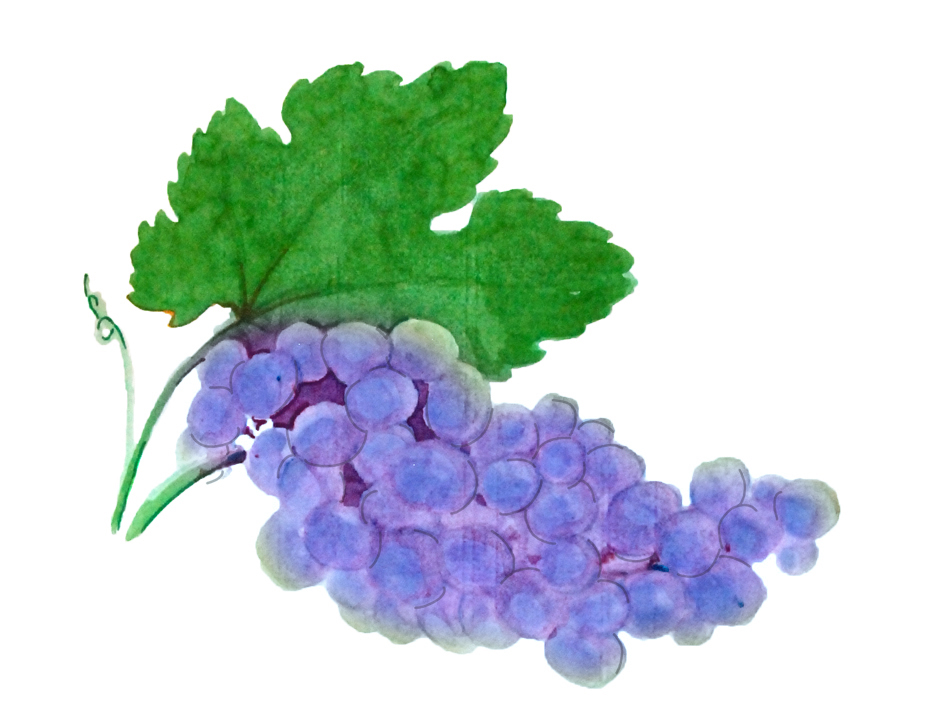
In Palu dialect it is called ekegit. The ripe bunches of grapes remain on the vines until the end of September or, more correctly, until the festival of the Holy Cross of Varak (near the end of that month). Harvesting in Palu is called either ekin mdnel (entering the vineyard) or ekin gtel (harvesting the vineyard) – in dialect they are synonymous.
The harvest has to wait until the tithe (one-tenth of the crop) is determined, and it only then that harvesting can take place. Thus the shahna (the designated official) arrives in the village, visits the vineyards taking the village meliks (elders), the res (headman), the kizir (headman’s aide), the secretary, the muhammis (assessors) as well as a number of vineyard owners with him. It is during this visit that the size of the harvest and therefore the tithe is determined. The harvest can begin after the shahna has departed.
The village headman’s aide then ascends the flat roof of a house in the village and, shouting from there, informs everyone in it that the grape harvest is to start the next day. The news immediately spreads from one house to another and even reaches the local Kurdish-populated villages. Every family prepares all the tools and things necessary for the harvest – hampers, cutters, sheets, carpets and baskets.
The next morning they all take the journey to the vineyards with donkeys and mules. The village practically empties – only about a quarter of its population remaining in it. The harvest may last for several days and during that whole period the people spend the nights in their vineyards. While some people begin to cut and harvest the bunches of grapes from the vines, others begin to transfer the harvest, packed into huge hampers and loaded on to the donkeys and mules, back to the village. The villagers try to complete the harvest as quickly as possible, as they have other more important work to do at the same time – threshing. It is the townsman that extends the harvesting for about two weeks and turns this period into that of enjoyment and feasting. [5]
The villager returns to the vineyard in October to collect the support staves (sarpina). Then he brings each vine’s branches together, lays them on the ground, covers them with soil, and adds a few stones on top. This is called ‘stoning the vineyard’ (ekin karel); the object of doing this is to protect them from the winter cold, especially as during the cold weather the temperature can drop from -20 to -25 degrees Centigrade (-4 to -13 Fahrenheit). The vines remain in this state until the spring. Then the villager returns to the vineyard, brings the branches out of the soil, prunes them, replaces the supports and digs the circular trenches around the base of the vines once more. [6]
Pressing grapes
The majority of the grapes brought in from the harvest are pressed. A small portion, however, is kept for the winter period as fresh fruit to eat. To this end a certain amount of both black and white grapes are selected and put into special containers by the people of Palu. The containers are called korodj or kordji. They are made from animal dung, are shaped like buckets, and the interior is coated with clay. In the first instance they line the floor of the container with flax or linseed chaff, or the just chaff (in other words the badly threshed pieces), then bunches of grapes are arranged loosely on it. They pour chaff over this first layer of grapes, then arrange a second layer and again add chaff, until the korodj (container) is full. They then get another korodj of the same size, turn it upside down and fit it over the first one like a lid. They then coat the places where the two containers meet, so as to leave no openings at all. Each korodj can hold 4-5 kilogrammes of grapes. The sealed containers are taken to the larder, where in a temperate situation the grapes may be kept fresh for three months. The containers are generally opened at New Year and Christmas; thus the grapes become one of the tasty dishes eaten during those festivals. [7]
Vineyard owners usually set aside a special place for the work of pressing (kmel) grapes. In the northern villages of the Palu district this building where grapes are pressed – generally known as hntsan – is called salk, while in the southern villages it is kur. A salk is a basin about 1.5 metres wide, 2 metres long and 40 centimetres deep (5 feet wide and 6 feet 6 inches long), whose bottom, as well as its sides, are tiled with flagstones set in place with carefully selected cement. By making it like this it is completely watertight, and the liquid filling it will not seep out. The salk’s bottom is gently sloped so that the wine must can flow out through a special fitted tap. The kur, on the other hand – also known as dashd – is made of wood. It is made of a large block, hollowed out to look like a cask. A tap is fitted to the bottom to allow the pressed wine must to flow out. Both the salk and kur are fitted to a stand about 20-25cm high (8-10 inches), and a large vessel is placed below the tap, into which the grape must flows. [8]
Large bags, one and a half metres long and one metre wide (5 feet wide and 3 feet 3 inches long), made from either sewn cloth or hair, are used for pressing. These bags are half filled with grapes and put into the salk. Each different kind of grape is pressed separately, of course. The kinug and khachgogh kinds of grapes are made into wine must, then wine, while grape syrup (roub or pekmez) and other sweet liquids are made from that of the other kinds of grape. The presser twists the open end of the bag shut and, holding it one hand, begins treading on the grapes in it. Every time the bulk of the bag lessens, the presser twists the end of the bag more, so that the contents remain squeezed inside it. When the grapes have been well pressed, the bag is opened and the remaining mass called guzgab and the skins and seeds, that all together is called shib, is removed.
Even while the pressing is taking place, the wine must buyers assemble in front of the vineyard owner’s house. They are generally from the town, or villagers, Kurds, beys or aghas that have come with their donkeys and mules. [9]
Grape syrup (roub), raisins, dried grape juice sheets (basdegh or pestil) and other sweets
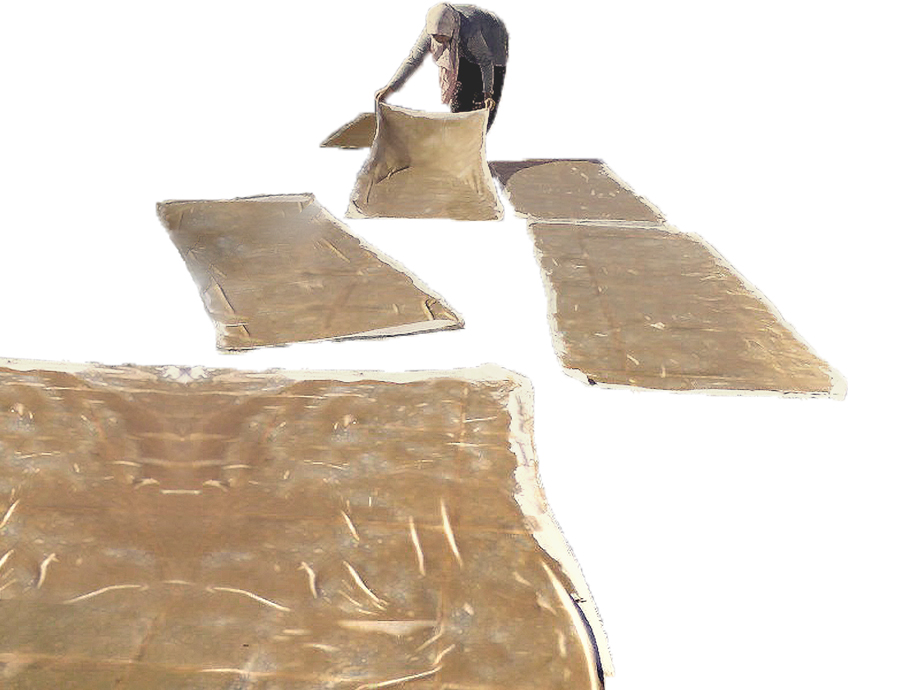
The Palu dialect is rich in words concerning grapes, something that demonstrates the importance of this fruit in the lives of the local Armenian populace. The person from Palu calls grapes khavogh. The unripe and bitter fruit is called azokh, the bunch goz, the bunch without pips guzgab and a small branch of a bunch djer. There are many kinds of grapes in Palu.
Those we know are the following:
White grapes (djermag khavogh), whose fruit is of a medium size, the skins being neither hard nor thick. They are usually only eaten fresh.
Red grapes (garmir khavogh), only grown to be eaten fresh.
Raisin grapes (chamchug), from which raisins are prepared.
Clean (makrug) or sweet (shakarig) that is very sweet.
Ox eye (yezan achk), that has large fruit.
The earliest (aghbekeri), a white grape which ripens earliest and has large fruit.
Must grapes (kinug) , from which wine must is prepared. This is the latest ripening grape, with thick skin; its must is also thick.
Cross-side (khachgogh) whose bunches are cross-shaped, its fruit tightly clustered, also used for preparing wine.
There are also black grapes (sev khavogh), murd, sparrow (djndjghug), Mary’s grapes (Mairum khavogh).
The villagers grow raisin grapes (chamchug) and must grapes (kinug) more than any of the others. [10]
Wine vinegar, used in Palu kitchens, is made from grapes that haven’t ripened well or from unripe bunches. [11]
Preparing raisins: After the grapes have ripened, all the bunches are left on the vines for a long time. The fruit gradually starts to wither, to dry and become raisins. During this time the vines have to be defended against potential thieves, the main ones being tortoises. During that time these animals come from the surrounding mountains and plains and make their homes in the vineyards. Among other dangers are bees and wasps, which always prefer the best quality ripe grapes. Sarkisian notes that among the thieves are the Kurds from the local villages who do not have their own vineyards; they secretly enter those belonging to other people and steal the crop.
There are also ways of turning grapes into raisins artificially. At the end of June, when the chamchug grapes have ripened, women and girls, taking small cauldrons, sesame oil (shirig) and potassiun with them, go to the vineyard. Choosing an area of 2 to 3 metres square (6 feet 6 inches to 9 feet 9 inches square), they flatten and clean it, putting all the things they have brought with them there. The cauldrons are filled with the potassium and, a fire having been built under them, are put to boil. At the same time others begin to harvest bunches of grapes. They submerge the bunches in the boiling cauldrons for a few minutes each, then take them out and line them up separately on the cleaned ground. The treated grapes remain there, under the open sky, for 10-15 days, after which the raisins will be ready.
The bunches of raisins are then brought home and the work of separating them from the stalks etc begins. [12]
The grape must doesn’t keep for very long. It can quickly turn bitter therefore work must start immediately to make the syrup (roub or pekmez), wine and other sweets from it. All this work takes place in the house yard or, as the people from Palu say in the tortan. The lady of the house puts cauldrons on the hearths and fills each of them with 60-70 okhas (okas) (76.8-89.6kg or 170-200lbs) of the must. The liquid begins to bubble over a gentle fire, and it is left for a long time. During this boiling time, a reddish substance called erbehogh is added to the cauldron and stirred. Thanks to this substance all the impurities separate out from the must and sink to the bottom (ravakhil). This substance also gives the syrup (roub) a red colour, making it different from that of mulberries, which is yellowish.
The lady of the house carefully attends to the changes occurring during boiling. She occasionally scoops up some of the liquid with a large ladle and lets it dribble back into the cauldron from some height. During this pouring, if the froth has turned red, then it means that the boiling has been completed. The result of this work is that two-thirds of the must has turned into steam, leaving a thick liquid in the cauldrons. The lady also knows another way to check the standard of the boil. She takes a little of the contents of the cauldron and fills a plate with it. If the must sticks to the plate like yogurt, it means that the liquid had boiled enough, so the cauldrons are taken off their fires. The lady continues to take up some of the thick liquid in the cauldrons with a ladle and lets it dribble back into the same ones. She continues to do this until the steam stops rising completely. All the work ceases and the syrup (roub) in the cauldrons is left to rest for one to two hours, until the temperature goes down until it only warm. [13]
The wine casks to hold the roub are brought up during the second stage. They must be completely dry, because even one drop of water will make all the roub bitter. The lady of the house says, aloud, ‘God be praised’ and begins to fill the casks with the roub. When they are full, the mouths are sealed, they are coated with clay and then stacked in the larder. [14]
Djemila and asida are also made from roub.
The preparation of djemila: An amount of roub is mixed with half its volume of water and mixed. Pure oil is added to this, then thin pieces of oven (tonir) bread are arranged in the mixture, one on top of the other. After being boiled for a minute or two the mixture becomes thick. It is removed from the fire and the djemila is ready. [15]
The preparation of asida: This is the people of Palu’s herushag (sesame sweet). First pure oil is burnt well in a pan. Then it is mixed with one hand with a circular motion, and flour is gradually dribbled into it with the other. The mixture is continually stirred over a gentle fire, until it is well scorched. A small amount is taken with a spoon and poured onto the roub that is nearby. If a bubbling action begins, then the roub is added to the scorched flour mixture little by little. Stirring continues until all the roub is completely absorbed by the flour. It is then made into little balls. The asida is ready. This sweet is eaten separately but is sometimes mixed with cream, butter or eggs. It is present on the tables set for engagements and marriages. It is also a permanent presence in the gifts (pai) sent to her future in-laws by an engaged girl’s family. When a death occurs this sweet is distributed, this time as a token of mourning to those visiting the deceased person’s home. [16]
The preparation of basdegh (dried grape juice sheets, pestil in Turkish): White grape must is preferred for this. It is boiled in a cauldron, and then a little erbehogh added to the liquid. This makes the unwanted dross to sink to the bottom and leaves the liquid clear. The boiling continues until froth appears on the surface. The lady of the house collects this froth with a ladle and throws it away. This has to continue until no more froth appears. Then, while swiftly stirring it constantly using a ladle with one hand, flour is gradually added. The flour must spread throughout the liquid, and must not form lumps. The prepared mixture is called malez, and in this particular case basdegh (dried grape juice sheets) malez. The cauldron with its contents is taken on to the flat roof where a clean cloth has been spread out. The malez is poured on to the cloth and spread evenly out on it, until it reaches an even thinness and glossiness. The coated cloths remain under the open sky for a number of days, until it is completely set. Then this dry roub is brought into the house, put upside down on a table – in other words with the dried grape juice sheets touching the table surface, with the cloth uppermost. The lady of the house is the main organiser of this work, and has clean water and a ball made of clean rags to hand. She begins to dampen the cloth with the wet ball, such that the grape juice sheets gradually come away from it. The separated basdegh is dried for some time, after which it is cut into even squares or triangles, then put into earthenware containers and sealed up with clay. [17]
Preparation of rodjig:Rodjig (cevizli sucuk in Turkish) is prepared from the mixture used to make basdegh. The shells are removed from walnuts and the nuts themselves strung on strings about half a metre long, a little apart, like a necklace. Almonds or kernels of apricot seeds may be used instead. These strings are completely dipped in the malez, then removed and hung up for a short time. Then they are dipped in the malez again and hung up once more. This is repeated three or four times. [18]
Wine
The villagers of Palu district generally drink wine in the winter. But this drink, with its flagon and goblet, are a necessary presence also at weddings, parties, festivals, hospitality or on wake tables. There are certain village in the Palu district, like Havav (now Ekinözu), Til (now Gömeçbağlar), Khoshmat (now Çakurkaş) and Terkhe (now Keklikdere), that are famous for their wine. It’s well known that wine preparation is an old tradition in Palu. Sarkisian writes that a number of monasteries in the region, among them Partstahaiyats and Khacha, keep hundreds of litres of wine in enormous earthenware vessels which are at least five centuries old. [19]
Wine is made from kinug and khachgogh grapes. The wine made from yezan achk grapes is sweet. The first operation in winemaking consists of treating the earthenware vessels (garas). A quantity of a form of tar called gbrtsiut is melted in a very large pan, and the vessels to take the wine are also heated. Then the lady of the house takes a long staff, one end of which has rags wrapped round it. She dips the cloth-covered end in the tar and coats the entire inside of the heated earthenware vessel with this black liquid. In the case of large vessels, the tar is melted in the vessel itself. After this is completed, it is left to set hard, and the vessels are then filled with grape must. They vessels are then closed with covers, leaving a small opening, so that the gas produced during the fermentation process can escape. The filled vessels are left in this state for a few days while the fermentation begins. During the following days it is possible to hear the gentle sound of fermentation. Some people leave the vessels like this for 40 days, after which the wine is ready. At that point the holes in the cask lids are sealed completely and coated to prevent air getting to the wine. The wine is now ready for use. [20]
Papazian tells us that, after the grape harvest and winemaking, it is the custom in Havav village for the women to visit each other in groups and look over the provisions and wine that have been put in the larder for future use. These mutual visits follow months of extremely hard work which, as we’ve seen in the above examples, the main worker is the lady of the house. Thus for the women, these visits are also chances for them to enjoy themselves, during which wine is drunk freely. [21]
Mulberry trees – Mulberries
This tree, with its importance, has a leading place in the ranks of fruit trees. Its wood, however, is hard and is considered unsuitable for building purposes and burning. It is only since 1895 that the people of Palu, following the examples of those of Kharpert/Harput and Diyarbekir, have begun sericulture and, for that purpose, to use the leaves of the mulberry tree. But this agricultural trade has never been achieved great production volume in the Palu district. The main reason is that the region has no real value in terms of trade, and the people from Palu have to personally visit the nearby trading towns to sell their goods. [22]
So for the villager of the Palu district, be he Armenian, Kurd or Turk, the value of the mulberry tree is always in its fruit. The best mulberries are called angut, while the people living in the southern part of the district call it indjir. It is white and is the sweetest among all the various kinds of mulberry. The harvesting of angut mulberries begins in May; for a whole month to a month and a half the berries are the daily staple fruit of both the villager and the townsman. There are other kinds of mulberry that ripen in the following months, such that there are fresh mulberries for the villager to eat until August. The villagers take the mulberries in small, conical baskets to the town and sell them in the market. Due to the crop being plentiful it is very cheap, and even takes the place of meals for the poor. The words ‘mulberry’, ‘cheapness’ and ‘poor’ have become closely linked in Palu. For example a tutbey (mulberry bey) is the name given to all the beys whose authority has been lost, and who’s rule only extends to mulberry tree groves. When the mulberry season begins, the people of Palu district have the habit of also saying ‘the spoons are in the spoon box’; in other words there is no need to eat meals with a spoon because for over a month mulberries will be an important part in daily nourishment.
Apart from angut, there are the following kinds of mulberry:
Merdjan (white)
Mor (red-coloured)
Ishtut (there are two kinds – red and white)
Grdjig
Bochud
Palud
Teghnud (yellowish). [23]
Mulberries have great importance in the rural economy of the Palu district. Apart from the fact that they eat them in their fresh state, the villagers use this fruit to make roub (syrup), basdegh (dried mulberry juice sheets), oghi (spirits) and sweets, all of which have their important place in their winter stores. Mulberries are also dried, milled and, made into flour, is used to make various kinds of malez.
The preparation of mulberry roub (syrup): The people of Palu call this tutroub or tte roub. Fresh mulberries are put into large basins and well squeezed by hand. Must appears that, to separate it from the lees, has to be passed through a very fine sieve. This is repeated several times, until the must is free from all foreign bodies. The basins containing the clear must are put out in the sun, the heat of which makes it boil, losing its water content and, eventually, becomes a thick, sticky liquid like malez. This product is already mulberry roub (syrup) that the villagers put into earthenware vessels and keep as winter stores. During the winter this stored roub thickens even more and hard grains of sugar form in it. The villagers say of this crystallisation: ‘the roub has sprung shoots’. Mulberry roub is eaten in this state or mixed it with butter, yogurt cream or torakh. [24]
Preparation of basdegh (mulberry syrup sheets, pestil in Turkish): After cleaning the mulberry roub (syrup) by passing it through a very fine sieve several times, it is put into a cauldron and boiled. The cauldron is kept on the fire until the must thickens and becomes malez. Then the malez is taken up on to the flat roof and spooned onto clean cloths a few metres long and half a metre wide. This is not enough, of course, to make the basdegh thin. So it is necessary to trowel it, until it is as thin as the piece of cloth itself and is glossy. The malez remains outside in this state for a few days, until the liquid part completely sets. Then this dry roub is brought into the house, and separated from the cloth as described for grape basdegh (see above). They are cut into similar size pieces and put into a shallow dish. The pieces are eaten in their plain state, but they can also be fried with oil and eggs. [25]
Mulberry roub (syrup) has other consumer uses. It is possible to prepare a sweet drink that in its simple state can be drunk or used in the preparation of cracked wheat (bulghur) pilav. The syrup has a use as medicine too, and is much used in rural medicine. Mulberry syrup is spread on abcesses to make them ripen, with the object of lancing and cleaning them. It is also said that mulberry syrup prevents the blood from thinning, so it is given to certain ill people as nourishment. It is also the custom to give it to all those who suffer from heart or stomach problems or simply from constipation. In these cases the syrup is half diluted with water and administered to the patients. [26]
Various sweets and drinks are also prepared by the people of Palu using mulberry syrup.
Mulberry kesme: This is a sweet made from grdjig mulberries. These are the latest ripening mulberries in the Palu district, remaining on the trees until the end of August. Unlike the other kinds, grdjig mulberries are generally drier, so less dust, soil and prickles stick to it. Once it harvested, it is brought home and spread out on the floor in the shade. After staying there for a few days, the grdjig mulberries dry out and become hard. Then the stalks are removed from each fruit and they are put into storage vessels, where they remain until December. Then they are brought out of the storage vessels and spread out once more, this time on the roof under the sun. After staying like that there for a complete day, they are collected up and milled using a grindstone, such that the whole fruit turns into dust. The resulting powder is called ttalir (tuti alur – mulberry flour). It is then put through a very fine sieve, then into copper tubs, taken up to the roof and put in the sun. After remaining there for a few hours, the flour becomes soft and somewhat sticky. It is then made it into cubes or pieces using a knife. All of the pieces are brought into the house and put into containers. The mulberry kesme is ready. [27]
Mulberry oghi(spirits): It is known in Palu dialect as arakh or arakhi. Wine and oghi are the main alcoholic drinks in the Palu district; the people of the town prefer oghi to wine. They are usually drunk during the winter. According to Sarkisian, people from Palu who have lived in Istanbul for many years and have returned to the place of their birth have the habit of consuming oghi throughout the year. [28]
The expert in distilling this drink is the lady of the house. In the first instance she fills earthenware vessels (garas) with the mulberries, and then adds water. To determine exactly how much water, a long, thin rod is pushed it into the vessel holding the mulberries, until it touches the bottom, and it is left there. The rod must remain vertical, or it would mean that too much water has been added. Then the vessel’s mouth is closed with cloth or clay and it is left for 7-8 days, until the mulberries ferment. The lady of the house, during this time, opens the mouth of the vessel every day and mixes the fermenting mulberries with the rod. There is a particular way of finding out if the fermentation has been completed. They bring a lighted taper near the vessel’s open mouth; if the flame goes out, then it means that the fermentation process is still continuing. If the flame remains burning, then it has finished. A scum appears on the surface, of which a cupful is collected. Very fine ash is added to the cup; if the liquid immediately begins to bubble, then the person preparing the oghi knows that the time for distillation has arrived. Work has to begin at once, because if the distillation time passes, or as the people of Palu say – the arakh has flown – then the oghi being prepared will be weak and unusable. [29]
For distilling purposes certain simple utensils (a copper cauldron, a circular container and a bucket) are needed. First, the entire contents of the vessel containing the liquor is poured into a cauldron. Then a bucket, which in this case is an earthenware vessel, is sunk into the liquor, so that that its open top is above the surface, preventing the mulberry liquid entering it. A heavy, clean stone is then put into the bucket so that it remains immovable under its weight. Into the same bucket is put a clean cloth containing juniper berries. Then aniseed with its stems is chopped up into small pieces and added to the fermented liquor and the mixture stirred. At this stage a basin, the same diameter as the cauldron, is placed upon it to act as a cover, filled with tepid water. Clay is applied to the place all round the rim of the cauldron where it touches the container being used as a lid, sealing it, so that no steam can escape. After all this has been done, the sealed cauldron is put on a gentle fire. Distillation begins. The fermented mulberry slowly liquor begins to rise, while the distilled oghi gradually begins to fill the bucket. The water in the lid serves to tell how the distillation is progressing. In other words, when the lady of the house puts her finger in the water and finds that it has become very hot, the distillation has come to an end. Then the basin is taken off the cauldron, the bucket is removed and its content is poured into bottles or flagons. The first distillation is called archi peran (first mouth), and the oghi is named archi perni oghi. This liqueur is comparatively strong and is considered to be of superior quality. [30]
A second distillation is made from the same liquor in exactly the same way. This time the oghi produced will be weaker. A third distillation of the same liquor produces the weakest oghi, with the least alcoholic content, and is called genga arakh (women’s oghi). After distillation, the cauldron only contains the mulberry lees, which they remove and mix with a kind of clay called gaghdji. This is used as plaster, with walls of rooms and rooftop summer house floors being coated with it to make them hard and glossy. [31]
There is another way of distilling oghi. A special still is used, called a lula or arakhi lula. It mostly uses the same tools and methods. The main difference is that the distilled liquid doesn’t fill a bucket. A pipe is fixed to the still and, when steam rises as a result of the heat of the fire, it passes down the pipeturns back into liquid and flows into a pitcher. Some people fit a cloth filled with aniseed into the pipe, so that the distilled oghi has to pass through it, taking on its smell and taste. [32]
Other trees
Here we will provide a list of all those trees whose wood and fruit, according to Sarkisian, are used by the people of Palu district for consumption or living.
Apricot: the people of Palu call it meshmesheni. After the mulberry, it is the second most important tree grown in the orchards. The fruit is mainly divided into two groups: khasi meshmesh, the kernels of whose stones are not bitter and leghi meshmesh, whose stones are. The latter are harvested, strung on to strings like beads on necklaces, are boiled with potassium, and then dried in the sun. This cooking rids them of their bitterness; then the strings of dried fruit are dipped in boiled syrup and so make rodjig. [33]
Blackberry: this fruit is dark red and has a bitter-sweet taste. [34]
Guilder rose bush: a fruit that is round and about the size of a chickpea. When ripe it is yellow. It is mixed with raisins and is a favourite children’s food. The tree is sacred for both the Armenians and the Kurds of the Palu district. It usually grows in the clefts of rocks. Whenever a villager passes one, he ties a piece of cloth or a rag to one of its branches as a sign of respect and worship. There is a custom among the Armenians of lighting candles on stones under this bush, praying and crossing themselves. [35]
Poplar: the timber from poplar trees has the greatest importance for building. Every size of beam, joist, pillar, timber for doorframes, chests or for making ceilings is made from its wood. Its advantage lies in the fact that it is soft and less infectious. Perhaps the most important thing is that it is straight, easing the carpenter’s work. It is for this reason that Poplar trees are to be found in all the stands of timber in the Palu district, and the villagers take great care of their growth. [36]
The oak tree is useful for all the villagers’ daily needs, the wood from which is used as firewood. The azduri, which is like a willow tree, is formed of long, delicate and easily bent branchlets. The latter are used by the villagers for making baskets and pads for carts. The wood from azarole, apricot, pear and apple trees is used for making domestic items, such as spoons and ladles. [38]
Morello cherries, plums, pears and apples are also plentiful in the Palu district. The kinds of pears remembered are khidjig, meghrug, potug and tsemrug. Apples and pears are sliced and put on strings, like necklaces. The dried pear and apple are known as dandzges and khndzorges respectively. [39] The mamokh is a kind of wild plum and has a bitter taste. It is smaller than an ordinary plum; it is dried and eaten with food during Lent. [40]
- [1] Rev Haroutiun Sarkisian (Alevor), Palu: its customs, educational and intellectual state and dialect, published by Sahag-Mesrob Press, Cairo, 1932, page 139-140. (In Armenian)
[2] Ibid., page 140-141.
[3] Ibid., page 141-145.
[4] Ibid., page 153-157.
[5] Ibid., page 158-162.
[6] Ibid., page 163-164.
[7] Ibid., page 168.
[8] Ibid., page 165-166.
[9] Ibid., page 166-167.
[10] Ibid., page 147-148.
[11] Ibid., page 148.
[12] Ibid., page 149-151.
[13] Ibid., page 169.
[14] Ibid., page 170.
[15] Ibid., page 171.
[16] Ibid.
[17] Ibid., page 172.
[18] Ibid., page 174-178.
[19] Ibid., page 174-175.
[20] Ibid., page 176-178.
[21] Dikran S Papazian, History of Havav village in Palu, published by Mshag, Beirut, 1960, page 134-136. (In Armenian)
[22] Sarkisian, op. cit., page 121-122.
[23] Ibid., page 123.
[24] Ibid., page 126. Torakh is a food made from a mixture of yogurt and water called tan. It is boiled to split it, and then strained. What is left is torakh – white and thick.
[25] Ibid., page 127-128.
[26] Ibid., page 124, 126.
[27] Ibid., page 280-130.
[28] Ibid., page 130.
[29] Ibid., page 130-131.
[30] Ibid., page 131-132.
[31] Ibid., page 132.
[32] Ibid., page 133.
[33] Ibid., page 135.
[34] Ibid., page 136.
[35] Ibid., page 136, 138.
[36] Ibid., page 120.
[37] Ibid., page 121.
[38] Ibid., page 137.
[39] Ibid., page 135.
[40] Ibid., page 136.
